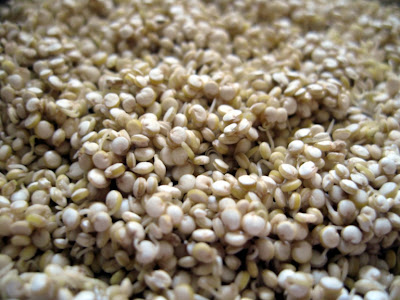Why sprout? There are several nutritional benefits, including added vitamins and minerals. It also helps digest the foods more easily. When in comes to grains, many even find the taste more appealing than ungerminated whole grains. Sprouting rice, specifically, can be beneficial for fighting diabetes, cardiovascular disease and postpartum depression. More information can be found here.

Sprouted brown rice: You should see small sprouts beginning to form, like tiny tails. This took approximately 48 hours.
The only real disadvantage is that you need to think ahead, though they keep well for a few days when refrigerated. Ever since school let out, I've been promising to make either andouille sausage for jambalaya or linguiça for paella. Since both involve rice, I figured it was easy enough to plan either way at this point, as I plan to make sausage over the weekend. (The wildcard will be whether or not I can find the file powder locally for the andouille.) I'm also planning on using quinoa soon, so started a batch of that, as well. Technically, it's a seed, but many of those sprout well, too.

Sprouted Quinoa - You can see how the seeds have softened and released tiny little sprouts. I started in the afternoon and already had sprouts by the next morning, so they go quickly.
Sprouting is easy. All you need are whole grains or seeds (rice or quinoa, in this instance) and a source of clean water. I use filtered because our tap water isn't great. I would recommend using water you're comfortable drinking. I should note that it's recommended you cook the sprouted foods, rather than further developing and eating raw, due to potential food-borne illness. You can use them just as you would the non-germinated products, though cooking times may be reduced.
Sprouted (Brown) Rice
- Rinse in strainer until water runs clear
- Pour into bowl and add 2-3 parts water to rice
- After approx 12 hours (or overnight), rinse again
- Once drained and rinsed, cover with a towel and place over a bowl to drain and begin to germinate at room temp (approx. 70 F), out of direct sunlight
- Rinse again after approx. 12 hours & repeat as necessary
Sprouted Quinoa
Follow steps 1 & 2 above, but drain and rinse after about 3-4 hours. Rinse again in 8-12 hours and repeat as needed. These should sprout quickly, within 24 hours.
0 comments:
Post a Comment
Thank you for your comment!